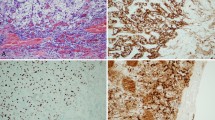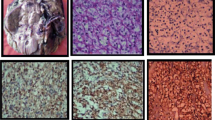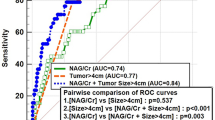Abstract
The objective of this prospective follow-up trial was to ascertain whether the urinary kidney injury molecule-1 (uKIM-1) associates with tumor tissue (tKIM-1) expression and with the pathological characteristics of clear renal cell carcinoma (cRCC) in radically nephrectomized (RN) and/or in partially nephrectomized (PN) patients with cRCC, pre- and postoperatively. This clinical study included 40 patients subjected to RN/PN (cRCC group) and 30 healthy volunteers (control group). Urinary KIM-1 was determined by ELISA TIM-1/KIM-1 kit and normalized by urinary creatinine. Immunohistochemical staining (monoclonal anti-human anti-TIM-1/KIM-1/HAVCR antibody) was used for semiquantitative analysis of the tKIM-1 expression and expressed as a score (% KIM-1 positively stained tubules). Both markers were interpreted in terms of the tumor characteristics comprising tumor size, Fuhrman grade, pathological (pT) stage, tumor/nodes/metastasis (TNM) stage, lymphovascular invasion and type of surgery RN/PN. Preoperative uKIM-1 was significantly higher in the cRCC group compared to controls, such as uKIM-1 was statistically higher in RN than in PN patients. Postoperatively, uKIM-1 decreased to control values. Expression of tKIM-1 was documented in all nephrectomized patients. Significant associations were achieved between uKIM-1 and tKIM-1 and with considered tumor characteristics, especially with tumor size and grade. Based on the accomplished associations, we found uKIM-1 as a highly sensitive marker for cRCC diagnosis.
The clinical trial registration number: 1110-2012.

Similar content being viewed by others
References
Siegel R, Ma J, ZouZ JemalA (2014) Cancer statistics. CA Cancer J Clin 64:9–29
Rini IB, Campbell IS, Escudier CB (2009) Renal cell carcinoma. Lancet 373:1119–1132
Lam JS, Klatte T, Kim HL, Patard JJ, Breda A, Zisman A, Pantuck AJ, Figlin RA (2008) Prognostic factors and selection for clinical studies of patients with kidney cancer. Rev OncolHematol 65(3):235–262
Bonventre JV (2008) Kidney Injury Molecule-1 (KIM-1): a specific and sensitive biomarker of kidney injury. Scand J Clin Lab Invest Suppl 241:78
Vilà MR, Kaplan GG, Feigelstock D, Nadal M, Morote J, Porta R, Bellmunt J, Meseguer A (2004) Hepatitis A virus receptor blocks cell differentiation and is overexpressed in clear cell renal cell carcinoma. Kidney Int 65:1761–1773
Han WK, Alinani A, Wu CL, Michaelson D, Loda M, McGovern FJ, Thadhani R, Bonventre JV (2005) Human kidney injury molecule-1 is a tissue and urinary tumor marker of renal cell carcinoma. J Am Soc Nephrol 16:1126–1134
Morrissey JJ, London AN, Lambert MC, Kharasch ED (2011) Sensitivity and specificity of urinary neutrophil gelatinase-associated lipocalin and kidney injury molecule-1 for the diagnosis of renal cell carcinoma. Am J Nephrol 34:391
Morrissey JJ, London AN, Luo J, Kharasch ED (2010) Urinary biomarkers for the early diagnosis of kidney cancer. Mayo Clin Proc 85:413–421
Lin F, Zhang PL, Yang XJ, Shi J, Blasick T, Han WK, Wang HL, Shen SS, Teh BT, Bonventre JV (2007) Human Kidney Injury Molecule-1 (hKIM-1): a useful immunohistochemical marker for diagnosing renal cell carcinoma and ovarian clear cell carcinoma. Am J Surg Pathol 31:377–393
TroungLD ShenSS (2011) Immunohistochemical diagnosis of renal neoplasm. Arch Pathol Lab Med 135:92–109
SobinL Gospodarowicz M, Wittekind C (2009) AJCC staging manual, 7th edn. Springer, Philadelphia
Levey AS, Stevens LA, Schmid CH, Zhang YL, Castro AF, Feldman HI, Kusek JW, Eggers P, Van Lente F, Greene T, Coresh J (2009) A new equation to estimate glomerular filtration rate. Ann Intern Med 150:604–612
SimicOgrizovic S, Bojic S, Basta-Jovanovic G, Radojevic S, Pavlovic J, KoturStevuljevic J, Dopsaj V, Naumovic R (2013) Tissue Kidney Injury Molecule-1 expression in the prediction of renal function for several years after kidney biopsy. Dis Markers 35:567–572
Zhang PL, Mashni JW, Sabbisetti VS, Schworer CM, Wilson GD, Wolforth SC, Kernen KM, Seifman BD, Amin MB, Geddes TJ, Lin F, Bonventre JV, Hafron JM (2014) Urine kidney injury molecule-1: a potential non-invasive biomarker for patients with renal cell carcinoma. Int Urol Nephrol 46:379–388
Cuadros T, Trilla E, Vilà MR, de Torres I, Vilardell J, Messaoud NB, Salcedo M, Sarró E, López-Hellin J, Blanco A, Mir C, Ramón y Cajal S, Itarte E, Morote J, Meseguer A (2013) Hepatitis A virus cellular receptor 1/kidney injury molecule-1 is a susceptibility gene for clear cell renal cell carcinoma and hepatitis A virus cellular receptor/kidney injury molecule-1 ectodomain shedding a predictive biomarker of tumour progression. Eur J Cancer 49:2034–2047
Shalabi A, Abassi Z, Awad H, Halachmi S, Moskovitz B, Kluger Y, Nativ O (2013) Urinary NGAL and KIM-1: potential association with histopathologic features in patients with renal cell carcinoma. World J Urol 31:1541–1545
Ku JH, Moon KC, KwakC Kim HH (2011) Significance of nuclear grade and tumor size in Korean patients with chromophobe renal cell carcinoma: a comparison with conventional renal cell carcinoma. Urol Oncol 29:487–491
Suzuki K, Mizuno R, Mikami S, Tanaka N, Kanao K, Kikuchi E, Miyajima A, Nakagawa K, Oya M (2012) Prognostic significance of high nuclear grade in patients with pathologic T1a renal cell carcinoma. Jpn J Clin Oncol 42:831–835
Morrissey JJ, London AN, Luo J, Kharasch ED (2010) Urinary biomarkers for the early diagnosis of kidney cancer. Mayo Clin Proc 85:413–421
Abassi Z, Shalabi A, Sohotnik R, Nativ O, Awad H, Bishara B, Frajewicki V, Sukhotnik I, Abbasi A, Nativ O (2013) Urinary NGAL and KIM-1: biomarkers for assessment of acute ischemic kidney injury following nephron sparing surgery. J Urol 189:1559–1566
Santiago-Agredano B, Álvarez-Kindelán J, Font-Ugalde P, Blanca-Pedregosa A, López-Beltrán A, Requena-Tapia MJ (2013) Prognostic value of microvascular invasion in predicting survival in renal cell carcinoma. Actas Urol Esp 37:504–512
Eisenberg MS, Cheville JC, Thompson RH, Kaushik D, Lohse CM, Boorjian SA, Costello BA, Leibovich BC (2013) Association of microvascular and capillary-lymphatic invasion with outcome in patients with renal cell carcinoma. J Urol 190:37–43
Acknowledgements
This study was supported by Grants from the Ministry of Defense of the Republic of Serbia (MFVMA/3/13-15, MFVMA/24/13-15) and Ministry of Education, Science and Technological Development of the Republic of Serbia (III41018). We are thankful to the reviewers for contributive suggestions and criticisms, helping us make this a much better paper.
Author information
Authors and Affiliations
Corresponding author
Rights and permissions
About this article
Cite this article
Mijuskovic, M., Stanojevic, I., Milovic, N. et al. Tissue and urinary KIM-1 relate to tumor characteristics in patients with clear renal cell carcinoma. Int Urol Nephrol 50, 63–70 (2018). https://doi.org/10.1007/s11255-017-1724-6
Received:
Accepted:
Published:
Issue Date:
DOI: https://doi.org/10.1007/s11255-017-1724-6




